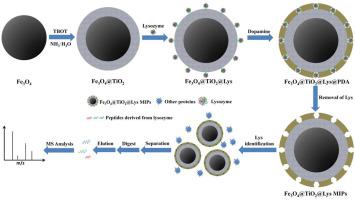Talanta ( IF 6.1 ) Pub Date : 2021-01-26 , DOI: 10.1016/j.talanta.2021.122143 Xiaowei Fang 1 , Zidan Wang 1 , Nianrong Sun 2 , Chunhui Deng 1

|
Many phosphoprotein biomarkers have been proved to exist in body fluids such as serum and urine, however, there is absence of rapid and efficient separation and identification method. In this study, we proposed to combine metal oxide affinity chromatography (MOAC), molecular imprinting technology (MIT) and matrix-assisted laser desorption ionization time-of-flight mass spectrometry (MALDI-TOF MS) to establish an effective approach to solve this problem. To verify the feasibility of this approach, we selected a typical phosphoprotein lysozyme (Lys) as template and magnetic TiO2 as substrate to prepare the molecularly imprinted nanoparticles (denoted as Fe3O4@TiO2@Lys MIPs). A point worth noting is that polydopamine (PDA) as polymer layer made Fe3O4@TiO2@Lys MIPs more hydrophilic and biocompatible. Thanks to the recognition sites of phosphate and the template-shaped cavities, Fe3O4@TiO2@Lys MIPs showed great sensitivity (0.01 ng*μL−1) and selectivity (Lysozyme: BSA: β-casein = 1:100:100, mass ratio) in standard phosphoprotein solution. At the end, the Fe3O4@TiO2@Lys MIPs showed great separation ability to lysozyme phosphoprotein in both human serum and urine samples. Therefore, the MOAC-based molecularly imprinted approach is worthy to be expected in effective separation of phosphoprotein biomarker in complex body fluid, which will be a promising one in future.
中文翻译:

基于磁性金属氧化物亲和层析的分子印迹方法有效分离血清和尿液磷蛋白生物标志物
许多磷蛋白生物标志物已被证明存在于血清和尿液等体液中,但缺乏快速有效的分离鉴定方法。在本研究中,我们提出将金属氧化物亲和色谱(MOAC)、分子印迹技术(MIT)和基质辅助激光解吸电离飞行时间质谱(MALDI-TOF MS)相结合,建立一种有效的方法来解决这一问题。问题。为了验证该方法的可行性,我们选择了一种典型的磷蛋白溶菌酶(Lys)作为模板,磁性TiO 2作为底物,制备了分子印迹纳米颗粒(记为Fe 3 O 4 @TiO 2@Lys MIP)。值得注意的一点是,聚多巴胺 (PDA) 作为聚合物层使 Fe 3 O 4 @TiO 2 @Lys MIP 更具亲水性和生物相容性。由于磷酸盐的识别位点和模板形空腔,Fe 3 O 4 @TiO 2 @Lys MIP 表现出极高的灵敏度(0.01 ng*μL -1)和选择性(溶菌酶:BSA:β-酪蛋白 = 1:100: 100,质量比)在标准磷蛋白溶液中。最后,Fe 3 O 4 @TiO 2@Lys MIP 对人血清和尿液样品中的溶菌酶磷蛋白表现出出色的分离能力。因此,基于MOAC的分子印迹方法在复杂体液中磷蛋白生物标志物的有效分离中值得期待,在未来具有广阔的应用前景。


























 京公网安备 11010802027423号
京公网安备 11010802027423号